Por favor, use este identificador para citar o enlazar a este item:
http://hdl.handle.net/10261/44778COMPARTIR / EXPORTAR:
 SHARE SHARE
 CORE
BASE CORE
BASE
|
|
| Visualizar otros formatos: MARC | Dublin Core | RDF | ORE | MODS | METS | DIDL | DATACITE | |

| Título: | Eicosanoids in the Innate Immune Response: TLR and Non-TLR Routes |
Autor: | Alvarez, Yolanda CSIC ORCID; Valera, Isela CSIC ORCID; Municio, Cristina CSIC ORCID; Hugo, Etzel; Rodríguez Peña, Mario CSIC ORCID CVN ; Fernández, Nieves CSIC ORCID; Sánchez Crespo, Mariano CSIC ORCID | Fecha de publicación: | 2010 | Editor: | Hindawi Publishing Corporation | Citación: | Mediators of Inflammation (2010) | Resumen: | The variable array of pattern receptor expression in different cells of the innate immune system explains the induction of distinct patterns of arachidonic acid (AA) metabolism. Peptidoglycan and mannan were strong stimuli in neutrophils, whereas the fungal extract zymosan was the most potent stimulus in monocyte-derived dendritic cells since it induced the production of PGE2, PGD2, and several cytokines including a robust IL-10 response. Zymosan activated κB-binding activity, but inhibition of NF-κB was associated with enhanced IL-10 production. In contrast, treatments acting on CREB (CRE binding protein), including PGE2, showed a direct correlation between CREB activation and IL-10 production. Therefore, in dendritic cells zymosan induces il10 transcription by a CRE-dependent mechanism that involves autocrine secretion of PGE2, thus unraveling a functional cooperation between eicosanoid production and cytokine production. | Descripción: | 14 páginas, 6 figuras.-- This is an open access article distributed under the Creative Commons Attribution License.-- et al. | Versión del editor: | http://dx.doi.org/10.1155/2010/201929 | URI: | http://hdl.handle.net/10261/44778 | DOI: | 10.1155/2010/201929 | ISSN: | 0962-9351 | E-ISSN: | 1466-1861 |
| Aparece en las colecciones: | (IBGM) Artículos |
Ficheros en este ítem:
| Fichero | Descripción | Tamaño | Formato | |
|---|---|---|---|---|
| Innate_Immune_Response.pdf | 4,85 MB | Adobe PDF |  Visualizar/Abrir |
CORE Recommender
PubMed Central
Citations
19
checked on 20-abr-2024
SCOPUSTM
Citations
29
checked on 24-abr-2024
WEB OF SCIENCETM
Citations
28
checked on 25-feb-2024
Page view(s)
414
checked on 23-abr-2024
Download(s)
32
checked on 23-abr-2024

